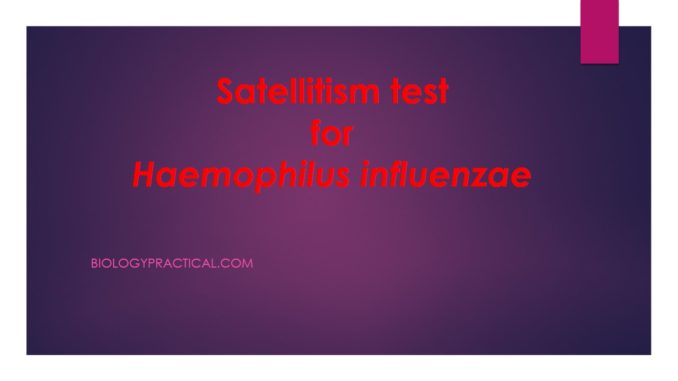
Principle:
- Haemophilus spp. typically grows on chocolate agar as smooth, flat or convex buff, or slightly yellow colonies. Chocolate agar provides hemin (X factor) and NAD (V factor), necessary for the growth of Haemophilus spp. Haemophilus influenzae needs both factors, hemin and NAD, for its growth. Blood agar contains hemin (factor X) but lacks NAD. NAD is also termed as V factor. Although H. influenzae requires both hemin and NAD, other Haemophilus species require only NAD for growth. Species that need NAD will not grow on Blood agar unless they are haemolytic and can release the NAD from the RBCs. However, they will grow well on Blood agar in vicinity to colonies of Staphylococci which are capable of providing NAD. Staphylococcus aureus, produce NAD as a metabolic by product which diffuses into the surrounding medium and enhances growth of Haemophilus in the proximity of the Staphylococcus colony. The phenomenon is known as Satellitism
Requirements:
- Microorganisms
– colony of hemolysin producing Staphylococcus aureus or Staphylococcus epidermidis strain - Clinical sample of Haemophilus influenzae
- Blood agar and Chocolate agar
- Sterile sticks or inoculating loop
- Incubator at 35°C
Procedure:
- Culture the sample containing H. influenzae in chocolate agar.
- Isolate a typical colony and perform Gram staining (H. influenzae is gram negative)
- Sub-culture the isolated colony to Blood agar and Chocolate agar.
- Then using a sterile inoculating loop place a single streak of Staphylococcus aureus on a blood agar plate that has been inoculated with a suspected Haemophilus influenzae
- Incubate plates for 24 h at 35 to 37°C in 5% CO2.
- Examine for the presence of colonies that satellite around staphylococcus streak on Blood agar.
- Use colonies from sub cultured chocolate agar plate to perform further tests for identification to the species level or for susceptibility testing.
Results interpretation:
- Positive test:
- A positive test is indicated by the growth of tiny colonies of Haemophilus influenzae surrounding the Staphylococcus streak.
- Staphylococcus lyses the red blood cells, releasing hemin (x factor) and NAD (v factor) for growth of Haemophilus spp. Therefore, Haemophilus spp. grow adjacent to the streak line where the nutrients are available.
- A positive result for a tiny gram-negative rod or coccobacillus suggests that the organism is of the genus Haemophilus.
- A positive result for a gram-positive coccus suggests a Granulicatella or Abiotrophia sp.
- Some microorganisms grow only on Chocolate agar and not on Blood agar even with a Staphylococcus dot. These include Francisella tularensis, Haemophilus ducreyi, and some Methylobacterium spp
- Negative test: Growth seen on Blood agar without the Staphylococcus dots is suggestive of negative test.

Limitations:
- Haemophilus ducreyi does not need V factor (NAD) but due to its dainty nature it does not grow on Blood agar even with the Staphylococcus dot.
- Haemophilus haemolyticus and Haemophilus parahaemolyticus may grow without the Staphylococcus and thus may not exhibit the satellite phenomenon even if they require V factor (NAD). Since they are haemolytic, they can release NAD into the medium.
- Brucella can be mistaken with Haemophilus; this test differentiates these genera, since Brucella spp. grow on Blood agar without Staphylococci to supply NAD.
